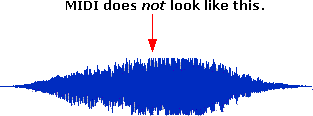|
<< Click to Display Table of Contents >> Appendix B: What is MIDI? |
  
|
|
<< Click to Display Table of Contents >> Appendix B: What is MIDI? |
  
|
MIDI (Musical Instrument Digital Interface) is an industry standard for passing musical performance information among electronic musical instruments and computers. There are very few details about MIDI that are neccessary for you to understand in order to use Musician. However, a general understanding about MIDI will help you to more quickly understand how Musician lets you create and edit both the music you see as notation and the music that you hear.
Most audio equipment that we are familiar with-- such as CD players and radios-- receive and send sound in the form of sound waves, such as shown below.

In contrast, MIDI instruments receive and send music data as specific actions to be performed, such as "play a Middle C note softly using the clarinet sound, for a duration of a quarter note at the current tempo." The MIDI instrument receiving such an instruction then produces the sound wave such as the one shown above.
When Musician (or any MIDI program) records a performance on a MIDI keyboard, Musician does not record the actual sound waves, such as shown above. Instead, Musician simply records what keys are played by the at what times, and with what loudness.
The following diagram illustrates MIDI note performance data. Each rectangle represents a single note that is to be performed using some instrument sound, such as a clarinet. The left edge of each rectangle marks the starting time of the note, and the right edge marks the ending time of the note. The vertical position of the rectangle represents the pitch of the note. This diagram does not illustrate the additional MIDI information for the loudness of the note.

A diagram of a MIDI performance, such as shown above, is commonly called "Piano Roll Notation" because it looks quite similar to piano rolls that were used in mechanical player pianos that were popular in the early 1900's. Each rectangle in the above diagram is like a hole in a piano roll. As the piano roll is scrolled during the performance, the player piano plays a key on the piano when it detects the hole, and releases the key when it detects the end of the hole.
A MIDI file is a saved recording of a MIDI performance. For a given song, a MIDI file is much smaller (as measured in bytes) than an equivalent audio recording of the song, saved in a .WAV or .MP3 file format or CD audio format. This is because only a few numbers are needed in the MIDI format to describe a note: its starting and ending times, pitch, loudness, and instrument sound. In contrast, tens of thousands of numbers are needed to describe the audio sound waves for just one second of music.